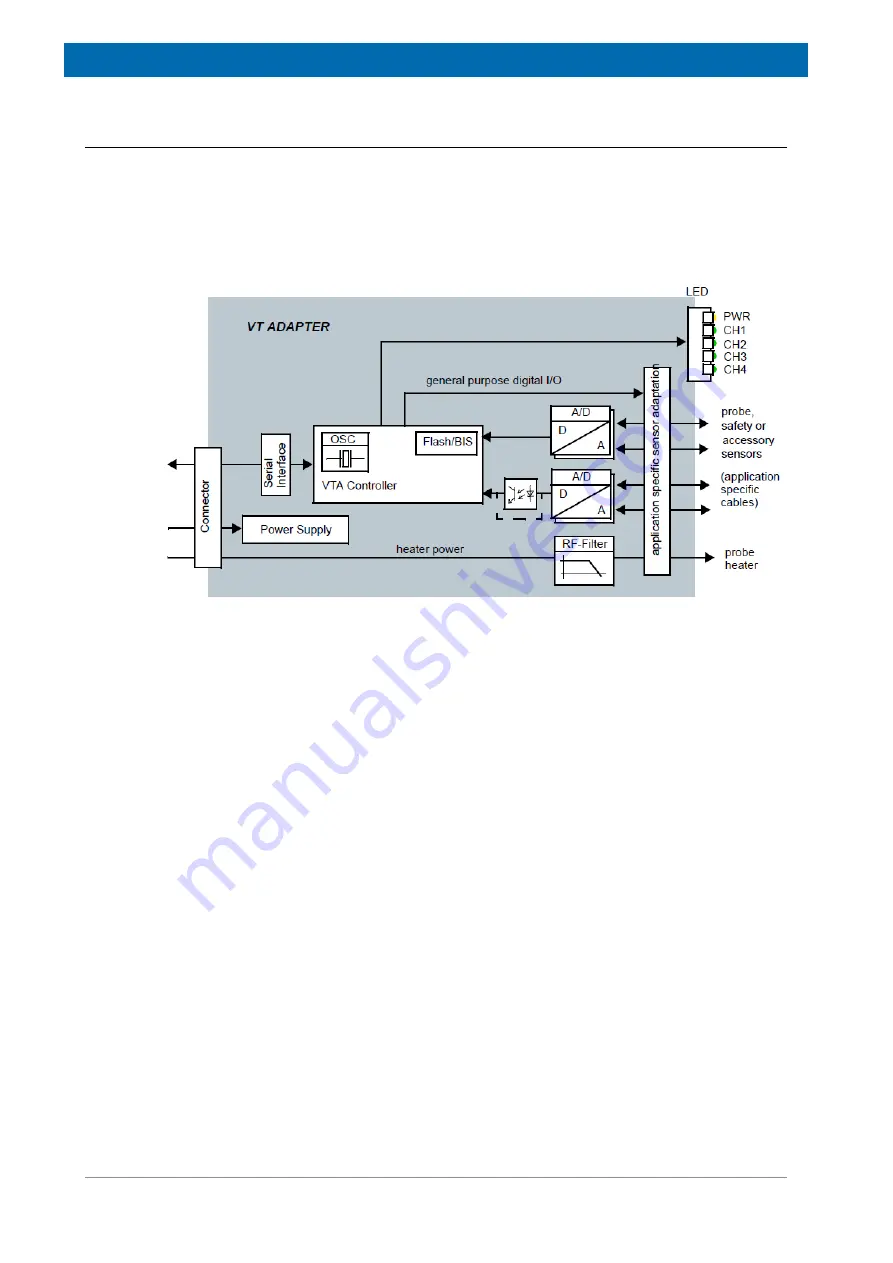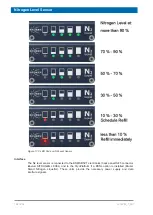
VTA
188 / 234
H172203_1_001
16.4
System Architecture / Overview
The primary function of the VTA is to adapt the various sensors and signals of probe and
chiller devices to the common interface of the BSMS integrated VT system.
Inside the VTA a common basic infrastructure for configuration, communication and board
identification (BIS) is available. Depending on the specific function these are complemented
by the appropriate number of ADC channels, galvanic isolation or sensor excitation signals.
Some VTA (e.g. for connecting a BCU) are equipped with solid-state switches.
Figure 16.2: Block Diagram of the VT Adapter
Thermocouple Adaptation (VTA TC-2T, TC-2E)
The thermocouple signal from the probe is fed into the VTA where the cold-junction
compensation and signal conversion is done. Simultaneous measurements of sensor
temperature and cold-junction temperature leads to precise results. The heater current is fed
through the VTA for RF filtering before entering the probe. A dedicated ADC channel is used
for measuring the safety temperature sensor that is mounted on the heater to prevent
overheating. Broken, ground-shorted or disconnected sensor lines are detected for safety
and diagnostic reasons.
Mainly for Solids NMR and high temperature applications there VTA offers two thermocouple
connectors. VTAs are fully operable with only one sensor connected. The open sensor line
will be ignored and the VTA behaves like a single sensor type.
BTO2000 Adaptation (VTA BTO)
The cold-junction compensated signal from the BTO2000 is fed into the VTA where the signal
conversion is done. The VTA BTO provides the power supply for the thermal oven and
electronics of the BTO2000. Apart from that the device provides the same functionality as the
TC-2T variant.
Summary of Contents for NMR AV4 BSMS System
Page 1: ...BSMS System for AVANCE NEO User Manual Version 001 Innovation with Integrity NMR...
Page 10: ...Contents x H172203_1_001...
Page 22: ...Safety 22 234 H172203_1_001...
Page 26: ...Transport Packaging and Storage 26 234 H172203_1_001...
Page 42: ...Chassis Mainframe 42 234 H172203_1_001...
Page 46: ...Fan Tray 46 234 H172203_1_001...
Page 55: ...ELCB H172203_1_001 55 234 Figure 8 1 ELCB Front Panel with LED s and Connectors...
Page 69: ...ELCB H172203_1_001 69 234 Figure 8 13 Lock RF Boards Diagnostics...
Page 70: ...ELCB 70 234 H172203_1_001...
Page 120: ...L TRX L 19F 120 234 H172203_1_001...
Page 148: ...BSVT Concept 148 234 H172203_1_001...
Page 166: ...SPB 166 234 H172203_1_001...
Page 172: ...VPSB DC and VPSB DC E 172 234 H172203_1_001 Figure 15 3 Block Diagram of the VPSB DC E...
Page 180: ...VPSB DC and VPSB DC E 180 234 H172203_1_001...
Page 187: ...VTA H172203_1_001 187 234 Figure 16 1 VTA Cable Connectors...
Page 193: ...VTA H172203_1_001 193 234 16 7 Ordering Information See Basic BSVT Configuration 124...
Page 194: ...VTA 194 234 H172203_1_001...
Page 200: ...Nitrogen Level Sensor 200 234 H172203_1_001...
Page 204: ...Radiation Shield Temperature Monitoring MAG RS 204 234 H172203_1_001...
Page 208: ...Installation and Initial Commissioning 208 234 H172203_1_001...
Page 210: ...Operation 210 234 H172203_1_001...
Page 216: ...Replacement of Parts 216 234 H172203_1_001...
Page 222: ...Contact 222 234 H172203_1_001...
Page 226: ...List of Figures 226 234 H172203_1_001...
Page 229: ...Glossary H172203_1_001 229 234 Glossary...
Page 230: ...Glossary 230 234 H172203_1_001...
Page 232: ...Index 232 234 H172203_1_001...
Page 233: ...H172203_1_001 233 234...
Page 234: ...Bruker Corporation info bruker com www bruker com Order No H172203...





































